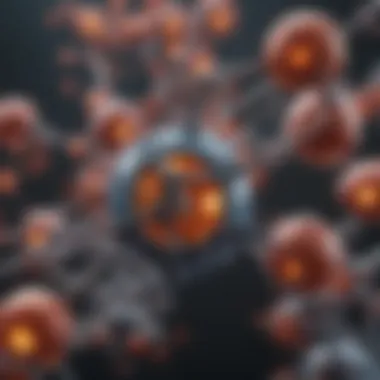Cell Death Mechanisms: Insights and Implications


Intro
Cell death is a fundamental biological process essential for maintaining homeostasis in multicellular organisms. The mechanisms by which cells die are not merely a passive outcome but rather an orchestrated event guided by intricate molecular pathways. Understanding these pathways is crucial, particularly in the context of health and disease
In the realm of biomedicine, the study of cell death mechanisms has gained increasing attention. This is driven by their implications in various contexts, such as cancer, neurodegeneration, and immune responses. By exploring the complexities associated with programmed and non-programmed cell death, we uncover vital insights that can influence therapeutic strategies.
Research Context
Background and Rationale
Cell death mechanisms can be broadly categorized into two types: programmed and non-programmed. Programmed cell death, which includes apoptosis and autophagy, is a tightly regulated process. Contrast this with necrosis, often viewed as a chaotic form of cell death resulting from acute cellular injury.
The relevance of studying these mechanisms lies in their critical role in pathophysiological states. For instance, in cancer, evasion of programmed cell death is a hallmark of tumorigenesis. Understanding how cancer cells escape these pathways can reveal potential therapeutic targets. Likewise, in neurodegenerative diseases, inappropriate cell death leads to significant cellular loss and dysfunction.
Literature Review
Extensive research has been carried out to unravel the complexities of cell death pathways. In recent years, newer concepts like ferroptosis have emerged, challenging traditional views. This pathway is characterized by iron-dependent lipid peroxidation and has gained attention due to its role in various diseases. Numerous studies have highlighted the connection between cell death mechanisms and disease progression.
For example, research published in Britannica highlights the intricate process of apoptosis. Meanwhile, literature available on Wikipedia provides a broader overview, including newer pathways like necroptosis and pyroptosis. These advancements prompt a more thorough investigation into the regulatory networks governing cell death.
Methodology
Research Design
The exploration of cell death mechanisms requires a multifaceted research design. A combination of experimental and computational approaches can provide comprehensive insights. In vitro studies using cell cultures allow for detailed examinations of specific pathways. Conversely, in vivo models offer a more systemic view of how these mechanisms operate in an organism.
Data Collection Methods
Key methods for data collection include:
- Flow cytometry for analyzing cell death markers
- Western blotting to study protein expressions associated with cell death
- Transcriptomic and proteomic analyses to discern genetic regulation
- Live-cell imaging techniques to observe real-time cell behavior
This combination of methodologies enables researchers to formulate a cohesive understanding of how cell death mechanisms contribute to overall health and disease.
Preface to Cell Death
Understanding cell death is essential for comprehending many biological processes and their implications in health and disease. Cell death mechanisms are complex and operate through various pathways that serve different purposes. These processes can be broadly categorized into programmed and non-programmed cell death. By studying these forms of cell death, researchers can uncover new insights into disease mechanisms and treatment strategies.
Definition and Importance
Cell death refers to the process through which cells cease to function, undergo structural changes, and eventually lead to their removal. This process can be deliberate, serving important functions, or it can be accidental, often leading to detrimental effects on surrounding tissues. Each type of cell death plays a critical role in maintaining cellular homeostasis and overall organismal health.
The importance of understanding cell death lies in its implications for various fields, especially medical research. Knowledge about apoptosis, necrosis, and other forms of cell death can provide insights into the progression of diseases such as cancer, neurodegenerative disorders, and inflammatory conditions. By integrating these insights, scientists can develop novel therapeutic approaches targeting specific cell death pathways.
Historical Context
The study of cell death has a rich history. It has evolved significantly over the decades. Early theories largely focused on necrosis as the predominant mechanism, emphasizing an uncontrolled process occurring after cellular injury. However, advancements in cellular and molecular biology have led to the recognition of programmed cell death, particularly apoptosis, which serves as a vital regulatory mechanism.
In the late twentieth century, researchers began to characterize various apoptotic pathways and components, such as caspases. The discovery of autophagy and ferroptosis added more layers of complexity to our understanding of cell death. Each of these mechanisms not only has distinct biochemical pathways but also impacts physiology and pathology in different ways.
Overall, studying cell death mechanisms is crucial for developing effective interventions in various diseases. With the growing body of research, the importance of understanding these processes expands further. This lays the foundation for future discoveries and therapeutic advancements.
Types of Cell Death
The mechanisms of cell death are essential to understand because they influence many biological processes. From development to disease, the way cells die has implications for organism health. This section will delve into the two broad categories of cell death: programmed and non-programmed.
Programmed Cell Death
Programmed cell death is a highly regulated process crucial for maintaining cellular homeostasis. Apoptosis is the most recognized form of programmed cell death, characterized by distinct biochemical features. Unlike necrosis, which is often uncontrolled, apoptosis is a deliberate mechanism. It plays a central role in normal development, tissue remodeling, and immune function.
In many cases, cells are designed to self-destruct when they are damaged or no longer needed. This eliminates potential threats to surrounding cells, such as damaged DNA that may lead to cancer. Moreover, during embryogenesis, programmed cell death shapes the development of various tissues by removing unnecessary cells, ensuring proper organ formation. The main paths of apoptosis can be divided into the intrinsic and extrinsic pathways, each having its triggers and regulators, which ensure only the damaged or redundant cells undergo death.
Non-Programmed Cell Death
Non-programmed cell death encompasses various forms where the mechanism is less controlled than in programmed cell death. One major type is necrosis, which often results from acute cellular injury such as trauma, infections, or inadequate blood supply. The main consequence of necrosis is inflammation, which can cause further damage to nearby cells.
In contrast to the orderly dismantling of a cell during apoptosis, necrosis leads to cell swelling, rupture, and an inflammatory response. This often exacerbates tissue damage and may lead to complications in healing.
Besides necrosis, other forms of non-programmed cell death can include entosis, where a living cell engulfs another, and necroptosis, a programmed form of necrosis that characters the immune response to certain stimuli. Understanding these processes can help researchers find potential interventions or therapies in conditions where cell death dysregulation leads to disease.
Apoptosis
Apoptosis is a vital process in cellular biology, representing programmed cell death. This mechanism plays a crucial role in maintaining tissue homeostasis, shaping development, and regulating the immune response. Understanding apoptosis is essential because it is involved in eliminating damaged or unwanted cells, thereby preventing potential diseases, including cancer. The intricate cycles of cell survival and death hinge on the proper execution of apoptotic pathways, suggesting that any disruption can lead to serious pathological conditions.


Pathways of Apoptosis
Apoptosis can be initiated through two primary pathways: the intrinsic and extrinsic pathways.
The intrinsic pathway is triggered by internal signals within the cell, often in response to stress such as DNA damage or oxidative stress. Central to this pathway are the mitochondria, which release cytochrome c and other pro-apoptotic factors into the cytoplasm, leading to caspase activation.
The extrinsic pathway, in contrast, is activated by external signals. It involves cell surface death receptors, such as Fas and TNF receptors, which respond to ligands from neighboring cells. Upon activation, these receptors recruit adaptor proteins that facilitate the activation of caspases, the critical enzymes that execute the death program.
Apoptosis ensures that cellular turnover is performed in a controlled manner, avoiding inflammation and damage to surrounding tissues.
Both pathways converge on the effector caspases, particularly caspase-3, which carry out the cell dismantling process.
Morphological Features
The morphological manifestations of apoptosis are quite distinct. Characteristic features include cell shrinkage, chromatin condensation, and membrane blebbing. As the process progresses, the cell's DNA undergoes fragmentation, resulting in the formation of small, membrane-bound apoptotic bodies. These apoptotic bodies are phagocytosed by surrounding cells or macrophages, preventing any inflammatory response associated with cell death. This process contrasts sharply with necrosis, where cell lysis leads to inflammation and damage to adjacent tissue.
Regulation of Apoptosis
Regulation of apoptosis is complex and involves numerous factors, including proteins from the Bcl-2 family, IAPs (inhibitor of apoptosis proteins), and various signaling pathways. Bcl-2 proteins can be either pro-apoptotic or anti-apoptotic, helping determine a cell's fate. Moreover, factors such as p53—a tumor suppressor protein—play a pivotal role by promoting apoptosis in response to cellular stress or damage. This regulatory framework is essential, as a dysregulation can contribute to diseases such as cancer, where resistance to apoptosis allows for unchecked cellular proliferation.
Necrosis
Necrosis plays a crucial role in understanding cell death mechanisms. Unlike programmed cell death, necrosis is often an uncontrolled process, typically resulting from acute injury, lack of nutrients, or toxic environments. This section addresses the multifaceted aspects of necrosis, focusing on its characteristics, causes, and pathophysiological consequences.
Characteristics of Necrosis
Necrosis exhibits several distinct characteristics that set it apart from other forms of cell death. Key features include:
- Loss of membrane integrity: Unlike apoptosis, where the cell membrane remains intact during the initial stages, necrosis involves a rupture of the membrane, leading to cell lysis.
- Cell swelling: During necrosis, cells often swell due to ion imbalances and water influx. This swelling disturbs cellular organization.
- Inflammatory response: Necrotic cells release their contents into the surrounding tissue, triggering an inflammatory response. White blood cells are recruited to the area, which can result in further tissue damage.
These characteristics illustrate that necrosis is not merely a passive process but one that can influence neighboring cells and overall tissue health.
Causes of Necrosis
Various factors can lead to necrosis, some of which include:
- Ischemia: Reduced blood flow deprives tissues of oxygen and nutrients, leading to cell death.
- Infections: Bacterial toxins can induce necrosis by damaging cell membranes and causing systemic inflammation.
- Toxic substances: Chemicals and drugs can disrupt cellular functions, resulting in necrotic cell death.
- Physical injury: Trauma can directly damage cells, prompting necrosis.
Understanding these causes is essential for developing strategies to prevent or mitigate necrosis in clinical settings.
Pathophysiological Consequences
Necrosis can lead to various pathophysiological outcomes, which can have significant implications for overall health. Some consequences include:
- Tissue damage: Necrosis can result in extensive tissue destruction, affecting organ function. For instance, myocardial necrosis during a heart attack leads to reduced cardiac output.
- Chronic inflammation: The infiltrating immune cells, responding to necrotic debris, can contribute to chronic inflammatory conditions, potentially exacerbating diseases like arthritis.
- Scarring and fibrosis: The body may attempt to heal necrotic areas by forming scar tissue. This process can lead to a loss of normal tissue function and elasticity.
"Necrosis is not merely the end of cell life; its aftermath can shape the function of surrounding tissues and the local immune response."
In summary, this section highlights that necrosis is significant in cell death mechanisms. The understanding of necrosis closes the gap between simple definitions and the complex realities of how cell death affects tissue health and disease progression.
Autophagy
Autophagy is a fundamental cellular process that maintains homeostasis by degrading and recycling cellular components. This mechanism has garnered significant attention in recent years, particularly due to its dual role in promoting cell survival under stress and contributing to cell death. Understanding autophagy is crucial for recognizing its implications in various health conditions.
Mechanisms of Autophagy
The process of autophagy involves several key steps:
- Initiation: Autophagy begins with the formation of a phagophore, a double-membraned structure that engulfs cellular debris.
- Phagophore Expansion: The phagophore expands to enclose damaged organelles or misfolded proteins, forming an autophagosome.
- Fusion: The autophagosome then fuses with a lysosome to create an autolysosome. Lysosomes contain enzymes that degrade the contents of the autophagosome.
- Degradation and Recycling: Finally, the contents are degraded, and the resulting smaller molecules, such as amino acids and fatty acids, are recycled back into the cytoplasm for various metabolic processes.
This process is meticulously regulated by various cellular signaling pathways, including mTOR signaling and AMPK activation, which respond to nutrient availability and stress levels.
Role in Cell Survival and Death
Autophagy plays a paradoxical role; it can be a lifeline for cells under stress or a trigger for cell death. Under conditions such as nutrient deprivation, autophagy helps cells to survive by providing essential nutrients through self-digestion. It is also protective against various cellular stressors, including oxidative stress and damaged organelles.
However, excessive or dysregulated autophagy can lead to cell death. In certain contexts, an increase in autophagic activity can promote cell death pathways, such as apoptosis and necrosis. Understanding the balance between cell survival and death mediated by autophagy is crucial for deciphering its role in diseases.
Autophagy and Disease
The impairment or alteration of autophagic processes has been implicated in various diseases, highlighting its importance in health and disease.
- Cancer: Autophagy has a complex relationship with cancer. In the early stages, it suppresses tumor formation by eliminating damaged organelles and proteins. However, established tumors may exploit autophagy for survival, especially under therapeutic stress, thus posing a challenge for treatment strategies.
- Neurodegenerative Diseases: Conditions like Alzheimer's and Parkinson's disease feature an accumulation of protein aggregates and damaged organelles, often due to defective autophagy. Enhancing the autophagic process may help clear toxic proteins and protect neurons from degeneration.
- Infectious Diseases: Autophagy also plays a role in the immune response by degrading intracellular pathogens, thus contributing to the body's defense against infections.
Autophagy is a double-edged sword, serving both as a protective mechanism and a potential pathway to cell death, depending on the context.
In summary, autophagy is a vital process that balances cell survival and death. Its implications for various diseases underscore the need for further research to understand its intricacies and potential therapeutic targets.
Ferroptosis


Ferroptosis represents a critical aspect of cell death research that has gained traction recently. This process, distinct from apoptosis and necrosis, involves a unique mechanism of cell death associated with iron and lipid peroxidation. Understanding ferroptosis can provide insights not only into fundamental biological processes but also into potential therapeutic strategies for various diseases. The relevance of ferroptosis extends to cancer, neurodegenerative disorders, and other conditions where cellular iron metabolism plays a pivotal role.
Discovery and Characteristics
Ferroptosis was first identified in 2012 by researchers who were exploring new forms of regulated cell death. The term "ferroptosis" derives from "iron" and "apoptosis", highlighting its fundamental dependence on iron ions. This type of cell death is characterized by the accumulation of lipid peroxides to lethal levels, causing cellular damage and eventual cell death.
Some key features that define ferroptosis include:
- Iron Dependence: Iron is crucial for lipid peroxidation, making the process unique compared to other forms of cell death.
- Lipid Peroxidation: The buildup of reactive lipid species is a hallmark of ferroptosis, leading to cellular dysfunction.
- Glutathione Depletion: A significant reduction in glutathione levels often precedes ferroptosis, affecting cellular antioxidant defenses.
Biochemical Mechanisms
The biochemical pathways that underlie ferroptosis are complex and involve several key players:
- Lipid Peroxidation: This process involves the oxidative degradation of lipids, which can lead to membrane damage and loss of cellular integrity.
- Role of Glutathione Peroxidase 4 (GPX4): GPX4 is a critical enzyme that protects cells from lipid peroxidation. Inhibition of GPX4 can trigger ferroptosis.
- Iron Metabolism: Cellular iron levels significantly influence ferroptotic cell death. Increased iron availability can escalate the production of reactive oxygen species (ROS).
Ferroptosis serves as a nonapoptotic form of cell death that is implicated in various pathological contexts. Understanding these biochemical pathways is essential for developing targeted therapies.
Ferroptosis in Disease Models
The implications of ferroptosis in disease models are profound. This form of cell death has been linked to several diseases:
- Cancer: Inhibiting ferroptosis can contribute to the survival of cancer cells, making it a potential target for cancer therapies.
- Neurodegenerative Diseases: Disorders such as Alzheimer’s and Parkinson’s have shown connections to ferroptosis, where neuronal cell death may be triggered by iron accumulation.
- Ischemic Injury: Ferroptosis plays a role in ischemic damage by exacerbating cellular injury during conditions of hypoxia and reoxygenation.
Ferroptosis continues to be an intriguing area of research, with ongoing studies aimed at delineating its precise role in various pathological conditions. By targeting ferroptosis, there may be opportunities to develop innovative treatment strategies that move beyond traditional approaches.
Caspases and Cell Death
Caspases are crucial enzymes in the process of apoptosis, acting as the executors of programmed cell death. Their importance cannot be overstated. Apoptosis is vital for maintaining cellular homeostasis, and caspases orchestrate this process through precisely regulated activation and interaction with various signaling molecules. Understanding the role of caspases provides insights into their global impact on health and disease. This section explores two key aspects of caspases: their role in apoptosis and the mechanisms that lead to their activation.
Role of Caspases in Apoptosis
Caspases are a family of cysteine proteases that play a central role in the apoptotic pathway. They function as initiators or effectors of the apoptosis process. Initiator caspases, such as caspase-8 and caspase-9, signal the start of apoptosis. They respond to different stimuli that signal cellular stress or damage. Once activated, they cleave and activate effector caspases, such as caspase-3, -6, and -7. These effector caspases carry out the morphological changes associated with apoptosis, including chromatin condensation, membrane blebbing, and DNA fragmentation.
The activation of caspases is a highly regulated process that ensures cells die only when necessary. Beyond their apoptotic role, they can influence inflammation and other cellular pathways. This dual function illustrates their critical role in not just eliminating unwanted cells but also responding to the immune challenges and protecting tissue health.
Caspases is a central point in balancing life and cell death along with maintaining cellular integrity.
Caspase Activation Pathways
Caspases are activated through two primary pathways: the intrinsic and extrinsic pathways. The intrinsic pathway is triggered by internal stress, such as DNA damage or oxidative stress. This pathway involves the mitochondrial release of cytochrome c, which forms a complex with Apaf-1, leading to the activation of caspase-9. In contrast, the extrinsic pathway is initiated by the binding of extracellular death ligands, such as Fas ligand, to their respective receptors on the cell surface. This interaction activates caspase-8.
Both pathways converge to activate downstream caspases, primarily caspase-3. This convergence underscores the tightly linked nature of these signaling cascades. Moreover, the regulation of caspases is vital; inhibitors, such as IAPs (Inhibitor of Apoptosis Proteins), can prevent their activation and thus permit cell survival even under conditions that would typically provoke cell death. Understanding these pathways and their regulatory mechanisms can shed light on how resistance to apoptosis can lead to disease, particularly in cancer.
In summary, caspases play crucial roles in apoptosis, acting as key mediators that determine cell fate. Their activation pathways illustrate a sophisticated level of control over cell death, which is essential for healthy tissue function. Thoroughly exploring these mechanisms will provide deeper insights into potential therapeutic targets for diseases characterized by dysregulated apoptosis.
Cell Death in Health
The concept of cell death serves essential roles in maintaining health and well-being. Despite its often negative connotation, the processes involved in cell death are integral to numerous physiological functions. They ensure that tissues and organs can function optimally and that homeostasis is preserved. Understanding cell death in health is critical for researchers and medical professionals alike, as it lays the foundation for how we approach various diseases and therapeutic strategies.
Cellular Homeostasis
Cellular homeostasis refers to the dynamic balance that cells maintain in response to internal and external changes. This balance is crucial for various cellular functions, including metabolism, growth, and adaptation. When cells undergo controlled death, it allows for the turnover of damaged or diseased cells, keeping the cellular environment stable.
Key aspects of cellular homeostasis include:
- Elimination of Damaged Cells: By removing cells that are no longer functioning properly, the body can prevent potential dysfunction and maintain tissue integrity.
- Regeneration: The death of certain cells can lead to the regeneration of new, healthy cells, which is vital during wound healing and tissue repair.
- Response to Stress: Cells can react to metabolic stress by undergoing programmed cell death, thereby avoiding the accumulation of dysfunctional cells that could lead to further health issues.
The understanding of how cellular homeostasis relies on cell death mechanisms is fundamental for grasping how organisms adapt and thrive.
Tissue Morphogenesis
During development, tissue morphogenesis is a critical stage where cells shape and organize themselves to form functional tissues and organs. Programmed cell death, particularly apoptosis, plays a vital role in this process.
Elements involved in tissue morphogenesis include:
- Formation of Structures: Certain tissues require the removal of specific cells to allow for the proper architecture. For instance, in embryonic development, the death of cells between fingers and toes allows for the formation of distinct digits.
- Guiding Cell Migration: The death of some cells can create pathways or spaces where other cells can migrate and proliferate.
- Balance Between Growth and Death: An equilibrium between cell proliferation and death is essential for normal tissue development and maintenance. Disruptions in this balance can result in congenital abnormalities or diseases such as cancer.
Cell Death in Disease
Cell death mechanisms play a crucial role in the context of various diseases. Understanding the processes of apoptosis, necrosis, and other forms of cell death illuminates how these mechanisms contribute to disease progression and potential recovery. Each type of cell death is associated with specific diseases, demonstrating the significance of monitoring and potentially manipulating these pathways for therapeutic purposes. By integrating insights into cell death, researchers can uncover new approaches in treatment and develop strategies to enhance patient outcomes.
Cancer
Cancer cells often evade normal cell death pathways, allowing for their survival and proliferation. The development of tumors is closely linked to this dysregulation of cell death mechanisms. Targeting apoptosis in cancer therapy aims to restore the natural regulation of cell death, pushing cancer cells toward their programmed demise.


- Resistance to Apoptosis: Many tumors develop resistance to apoptotic signals through various mechanisms, such as upregulating anti-apoptotic proteins or downregulating pro-apoptotic factors. This resistance can lead to treatment failure and disease progression.
- Therapeutic Approaches: Strategies that enhance apoptosis in cancer cells include the use of B mimetics, which inhibit anti-apoptotic proteins. These drugs have shown promise in restoring sensitivity to chemotherapy.
Research continues to explore how modulating apoptosis could improve therapeutic effects across different cancer types. This approach underscores the potential of tailored treatments that focus on homeostasis loss in cancer cells.
Neurodegenerative Diseases
Neurodegenerative diseases such as Alzheimer's, Parkinson's, and Huntington's disease are characterized by inappropriate cell death leading to neuron loss. In these conditions, both apoptosis and necrosis can contribute to the progression of neuronal death, exacerbating the disease process.
- Apoptosis in Neurodegeneration: Abnormal activation of apoptosis can lead to the death of neurons. Understanding the pathways involved can aid in developing neuroprotective strategies.
- Role of Neuroinflammation: Necrosis in neurodegenerative diseases often triggers inflammation, leading to a vicious cycle of neuronal injury. This highlights the importance of targeting cell death pathways alongside inflammatory processes in therapeutic strategies.
Research efforts prioritize identifying biomarkers of cell death to monitor disease progression and response to treatment.
Inflammatory Conditions
In the context of inflammatory diseases, cell death mechanisms serve both protective and pathogenic roles. Inflammatory responses can induce necrosis, contributing to local tissue damage, while regulated apoptosis can help clear damaged or infected cells.
- Necrosis and Inflammation: Necrotic cell death can release pro-inflammatory factors, amplifying the inflammatory response. This can be particularly detrimental in conditions like rheumatoid arthritis or inflammatory bowel disease, where ongoing inflammation perpetuates tissue damage.
- Apoptosis in Immune Regulation: Proper regulation of apoptosis is critical in maintaining immune homeostasis. Dysregulation can lead to autoimmunity, as seen in certain inflammatory diseases.
Ongoing research is essential to unravel these complex relationships and find ways to modulate cell death mechanisms effectively in inflammatory diseases. Understanding these dynamics can provide insights for developing more precise and effective therapeutic interventions.
Therapeutic Implications
The study of cell death mechanisms is crucial for developing novel therapeutic strategies. Understanding these processes can lead to better treatments for various diseases, particularly in oncology, neurodegenerative disorders, and inflammatory conditions. Therapeutic implications focus on how manipulating cell death can enhance treatment efficacy while minimizing side effects.
As therapeutic approaches evolve, two elements are often prioritized: specificity and efficacy. Therapies that can selectively induce cell death in diseased cells without harming healthy cells become essential. This selectivity provides an avenue for targeted cancer therapies where tumor cells can be selectively targeted, preserving healthy tissue.
The implications of these therapies extend beyond treatment. They can also influence diagnostic tools, enabling advancements in biomarkers that predict how cells respond to therapies. For clinicians, a deep understanding of how to modulate cell death mechanisms opens doors to personalized medicine, tailoring treatments to individual patient profiles based on their unique cellular responses.
"By targeting specific cell death pathways, researchers hope to shift the balance of disease versus health, favoring therapeutic outcomes."
Targeting Apoptosis in Cancer Therapy
Apoptosis, a form of programmed cell death, plays a significant role in cancer therapy. Cancer cells often acquire resistance to apoptosis, which contributes to tumor growth and survival. Thus, re-sensitizing these cells to undergo apoptosis is crucial.
Currently, various strategies target the apoptosis pathway:
- Bcl-2 Inhibitors: Medications like Venetoclax target Bcl-2 proteins, re-enabling the apoptotic process in certain cancers.
- Death Receptor Agonists: These agents stimulate death receptors on cancer cells, prompting apoptosis.
- Chemotherapeutic Agents: Many standard treatments work by triggering apoptosis through damaging DNA or inhibiting essential cellular functions.
Each method presents benefits and challenges, underscoring the need for a nuanced understanding of cellular mechanisms.
Modulating Autophagy for Therapeutic Gain
Autophagy, often viewed as a survival mechanism, can also lead to cell death under specific circumstances. Scientists are exploring how to strategically modulate autophagy in disease contexts.
In some cancer types, promoting autophagy can enhance chemotherapy effectiveness by removing damaged organelles, thus allowing for better cellular recycling. However, in other scenarios, suppressing autophagy may lead to increased apoptosis, thus providing a therapeutic window for treatments.
Key considerations in harnessing autophagy include:
- Timing of Modulation: Identifying when to enhance or suppress autophagy can influence treatment outcomes.
- Type of Disease: The role of autophagy differs widely across diseases. Understanding these differences is essential for treatment design.
- Combination Therapies: Combining autophagy modulators with other treatments may yield synergistic effects.
Ferroptosis as a Novel Target
Ferroptosis is an emerging form of regulated cell death characterized by iron-dependent lipid peroxidation. Its unique mechanism presents a new target in cancer therapy. Understanding ferroptosis offers the potential to develop therapies that can exploit this pathway effectively.
Emerging research indicates that certain cancers may be susceptible to ferroptosis, and inducing this type of cell death could offer an additional strategy to combat tumor growth. This could involve:
- Iron Manipulation: Using iron chelators can increase susceptibility to ferroptosis in some cancer cells.
- Lipid Peroxidation Inducers: Drugs that promote lipid peroxidation can trigger ferroptosis in various tumor types.
Notably, targeting ferroptosis also plays a role in neurodegenerative diseases. By either inducing or inhibiting ferroptosis, researchers aim to find the right balance in cellular health and disease progression.
Finale
The conclusion of this article serves as a synthesis of the key themes discussed throughout. Understanding the mechanisms of cell death is not merely an academic exercise; it has profound implications for both health and disease management. The exploration of various cell death pathways—particularly apoptosis, necrosis, and the novel concept of ferroptosis—encompasses critical aspects of cellular biology. Each type of cell death plays a specific role in physiological processes and highlights the diverse strategies the body employs to maintain cellular balance.
Throughout the article, we detailed how programmed cell death, such as apoptosis, is essential for normal development and tissue homeostasis. In contrast, non-programmed cell death like necrosis often occurs under pathological conditions, leading to inflammation and tissue damage. This distinction is crucial for developing therapeutic strategies aimed at manipulating cell death pathways. With options now including targeting apoptosis in cancer therapy or modulating autophagy for improved health outcomes, the medical field has exciting avenues to explore.
The implications of these insights extend to various conditions, from cancer to neurodegenerative diseases, where altered cell death mechanisms can influence disease progression and treatment responses. This underscores the necessity for continued research in this domain, focusing on how the interplay of different cell death mechanisms can be leveraged for therapeutic gain.
"Understanding cell death mechanisms is key to unlocking new treatments and improving health outcomes."
Summary of Key Points
- Diverse Mechanisms: The article has classified cell death into programmed and non-programmed processes, detailing key types.
- Diseases Involved: Understanding cell death sheds light on numerous diseases, including cancer and neurodegenerative disorders.
- Therapeutic Potential: Novel strategies are being explored to target these mechanisms for better therapeutic outcomes.
Future Directions in Research
As we look ahead, several areas warrant further exploration:
- Integration of Pathways: Future studies ought to investigate how various cell death pathways interact with each other. This could elucidate compounded effects in disease states, revealing potential targets for intervention.
- Biomarkers for Cell Death: Identifying reliable biomarkers to monitor cell death mechanisms might enhance diagnostic and predictive capabilities in clinical settings.
- Personalized Medicine: Research should aim towards tailoring therapies based on an individual’s specific cellular death profiles, emphasizing a more personalized approach in treatment.
- Novel Therapies: Continued investigation into compounds that can manipulate cell death pathways may lead to breakthroughs in chronic diseases.
Overall, the concept of cell death is central to our understanding of life at the cellular level. Ongoing research in this area promises to yield innovative strategies for addressing some of the most challenging health issues faced today.



